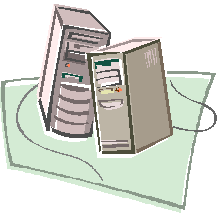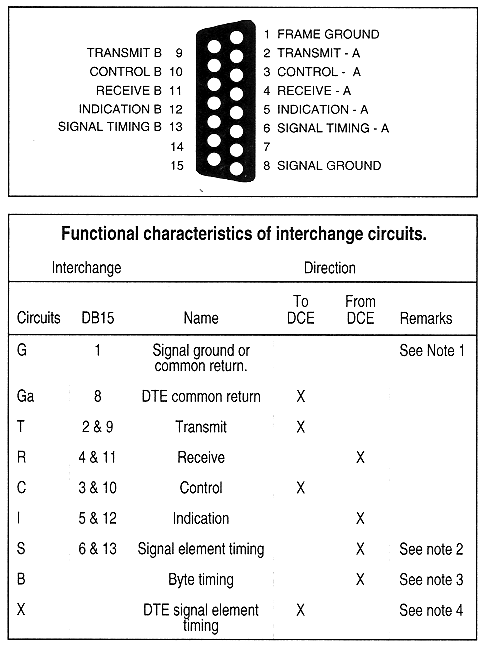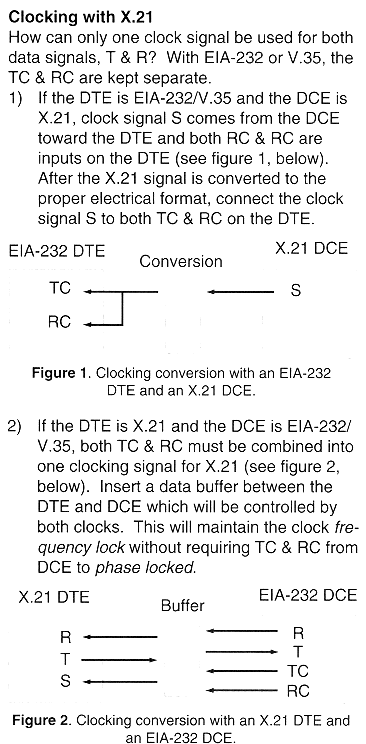| The X21 Protocol | Home |

Certifications

Cisco

Downloads

IP

PC

Protocols

RemoteAccess

Security

Telecommunications

Tools

Unix

Web
The X21 Protocol
CCITT X.21 is a physical and electrical interface that uses two types of
circuits:
balanced (X.27N.1 1) and and unbalanced (X.26N.10). CCITT X.21 calls
out the DB-15 connector.
The physical interface between the DTE and the local PTT-supplied DCE is defined in ITU-T recommendation X.21. The DCE provides a full-duplex, bit-serial, synchronous transmission path between the DTE and the local PSE. It can operate at data rates from 600bps to 64Kbps. A second standard, X.21bis has been defined for use on existing (analogue) networks. An X.21bis is a subset of EIA-232D/V.24 therefore allowing existing user equipment to be readily interfaced using this standard. It should perhaps be emphasized here that V24 defines the data terminal equipment interface to the modem and is not concerned with the interface between the modem and the line itself. The modems themselves therefore form part of the conceptual physical connection. The V24 interface is thus independent of both modulation technique and data throughput rate.
The X.21 interface protocol is concerned only with the set-up and clearing operations between DTE and DCE associated with each call. The control of the ensuing data transfer is the responsibility of the link layer.
X.21 Overview
X.21 is a state-driven protocol running full duplex at 9600 bps to 64 Kbps with subscriber networks. It is a circuit-switching protocol using Synchronous ASCII with odd parity to connect and disconnect a subscriber to the public-switching network.
The data-transfer phase is transparent to the network. Any data can be transferred through the network after Call Establishment is made successfully via the X.21 protocol. The call-control phases which are used were defined in the CCITT (now ITU) 1988 "Blue Book" Recommendations X.1 - X.32.
Signals Provided
The signals of the X.21 interface are presented on a 15-pin connector defined by ISO Document 4903. The electrical characteristics are defined in CCITT Recommendations X.26 and X.27, which refer to CCITT Recommendations V.10 and V.11.
X.21 provides eight signals:
|
Signal Ground (G) - |
This provides reference for the logic states against the other circuits. This signal may be connected to the protective ground (earth). |
|
DTE Common Return (Ga) - |
Used only in unbalanced-type configurations (X.26), this signal provides reference ground for receivers in the DCE interface. |
|
Transmit (T) - |
This carries the binary signals which carry data from the DTE to the DCE. This circuit can be used in data-transfer phases or in call-control phases from the DTE to DCE (during Call Connect or Call Disconnect). |
|
Receive (R) - |
Controlled by the DTE to indicate to the DCE the meaning of the data sent on the transmit circuit. This circuit must be ON during data-transfer phase and can be ON or OFF during call-control phases, as defined by the protocol. |
|
Indication (I) - |
The DCE controls this circuit to indicate to the DTE the type of data sent on the Receive line. During data phase, this circuit must be ON and it can be ON or OFF during call control, as defined by the protocol. |
|
Signal Element Timing (S) - |
This provides the DTE or DCE with timing information for sampling the Receive line or Transmit line. The DTE samples at the correct instant to determine if a binary 1 or 0 is being sent by the DCE. The DCE samples to accurately recover signals at the correct instant. This signal is always ON. |
|
Byte Timing (B) - |
This circuit is normally ON and provides the DTE with 8-bit byte element timing. The circuit transitions to OFF when the Signal Element Timing circuit samples the last bit of an 8-bit byte. Call-control characters must align with the B lead during call-control phases. During data- transfer phase, the communicating devices bilaterally agree to use the B lead to define the end of each transmitted or received byte. The C and I leads then only monitor and record changes in this condition when the B lead changes from OFF to ON, although the C and I leads may be altered by the transitions on the S lead. This lead is frequently not used. |
X.21 Protocol Operation
As stated previously, X.21 is a state protocol. Both the DTE and DCE can be in a Ready or Not-Ready state.
The Ready state for the DTE is indicated by a continuous transmission of binary 1's on the T lead. The Ready state for the DCE is continuous transmission of binary 1's on the R lead. During this continuous transmission of Ready state, the control leads are OFF.
During the Not-Ready state, the DCE transmits binary 0's on the R lead with the I lead in the OFF state.
The DTE Uncontrolled Not-Ready is indicated by transmission of binary 0's with the C lead in the OFF state. The DTE Uncontrolled Not-Ready state signifies that the DTE is unable to accept calls due to an abnormal condition.
The DTE Controlled Not-Ready state sends a pattern of alternating 1's and 0's on the T lead with the C lead OFF. This state indicates that the DTE is operational, but unable to accept incoming calls.
The characters sent between the DTE and DCE during call-control phases are International Alphabet 5 (IA5), defined by CCITT Recommendation V.3. At least two Sync characters must precede all sequences of characters sent between the DTE and DCE to establish 8-bit byte synchronization between the transmitter and the receiver. If the Byte Timing (B) lead is used, these Sync characters must align with the B lead timing signals.
Electrical Characteristics.
Data signaling rates of 9600 bit/s and below. X.27 (= V. 11) & X.26 (= V. 10)
Data signaling rates above 9600 bps. X.27 (= V. 11)
[V.10 specifies an interface circuit with an unbalanced transmitter with a differential receiver.]
[V.11 specifies an interface circuit with a differential, balanced signal from transmitter to receiver which may accommodate an optional DC offset voltage. This approximates EIA-4221

Equivalent/Corresponding EIA-232 or CCITT V.35 signals
Transmit = TD Receive = RD Control = RTS Indication = CD
Signal Element Timing = TC & RC (see note 2) Byte timing: rarely used.
DTE signal element timing : even more rarely used. Not supported.

Last modified: October 26 2003.